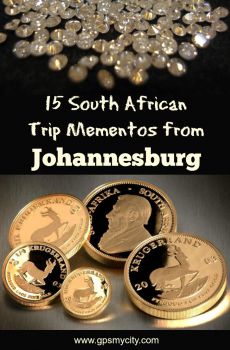Old Fort, Johannesburg (must see)
The Old Fort complex began in 1892 when a high-security prison was built to house white male prisoners. In 1896, Paul Kruger, then president of the South African Republic, decided to build a fort around this prison to protect the country from the threat of British invasion. In later years, the fort was also used as a prison. Ironically, it was at this place where the Boer military leaders of the Anglo-Boer War were imprisoned by the British.
The Old Fort prison complex was later extended to include "native" cells, called Section 4 and Section 5, and, in 1907, a women's section was added. An awaiting-trial block was constructed in the 1920s. Both political activists opposed to apartheid and common criminals were held at the prison. Mahatma Gandhi was imprisoned here in 1906, and striking white mineworkers in 1907, 1913 and 1922.
Under the apartheid government, only whites were held in the Old Fort itself, except for Nelson Mandela, who was given a bed in the hospital section when he was as an awaiting-trial prisoner in 1962 prior to the Rivonia Trial. Joe Slovo, Bram Fischer, Albert Luthuli, and Robert Sobukwe were also inmates. The site housed prisoners until 1983 when it was closed.
Nowadays the site hosts the Women's Gaol Museum, Number Four Museum, and the Old Fort Museum with exhibitions on history and human rights in South Africa.
Tips:
You can go into the cells, see and touch. There are signs everywhere in English to give you more information, as well as an orientation film to start. There is also an exhibition on Mandela and Gandhi.
Go for the guided tour. You'll get so much more out of it (and it's only a few dollars extra)!
The Old Fort prison complex was later extended to include "native" cells, called Section 4 and Section 5, and, in 1907, a women's section was added. An awaiting-trial block was constructed in the 1920s. Both political activists opposed to apartheid and common criminals were held at the prison. Mahatma Gandhi was imprisoned here in 1906, and striking white mineworkers in 1907, 1913 and 1922.
Under the apartheid government, only whites were held in the Old Fort itself, except for Nelson Mandela, who was given a bed in the hospital section when he was as an awaiting-trial prisoner in 1962 prior to the Rivonia Trial. Joe Slovo, Bram Fischer, Albert Luthuli, and Robert Sobukwe were also inmates. The site housed prisoners until 1983 when it was closed.
Nowadays the site hosts the Women's Gaol Museum, Number Four Museum, and the Old Fort Museum with exhibitions on history and human rights in South Africa.
Tips:
You can go into the cells, see and touch. There are signs everywhere in English to give you more information, as well as an orientation film to start. There is also an exhibition on Mandela and Gandhi.
Go for the guided tour. You'll get so much more out of it (and it's only a few dollars extra)!
Want to visit this sight? Check out these Self-Guided Walking Tours in Johannesburg. Alternatively, you can download the mobile app "GPSmyCity: Walks in 1K+ Cities" from Apple App Store or Google Play Store. The app turns your mobile device to a personal tour guide and it works offline, so no data plan is needed when traveling abroad.
Old Fort on Map
Sight Name: Old Fort
Sight Location: Johannesburg, South Africa (See walking tours in Johannesburg)
Sight Type: Museum/Gallery
Guide(s) Containing This Sight:
Sight Location: Johannesburg, South Africa (See walking tours in Johannesburg)
Sight Type: Museum/Gallery
Guide(s) Containing This Sight:
Walking Tours in Johannesburg, South Africa
Create Your Own Walk in Johannesburg
Creating your own self-guided walk in Johannesburg is easy and fun. Choose the city attractions that you want to see and a walk route map will be created just for you. You can even set your hotel as the start point of the walk.
Johannesburg Introduction Walking Tour
Johannesburg, or Joburg, or "City of Gold", as it is often informally called, is South Africa's largest city. The area's original inhabitants included hunter-gatherers from the San tribes and the Ndebele, a tribe associated with the Zulu. A gold rush in 1884 lead to Johannesburg's founding in 1886. Within a decade, the population had grown to 100,000 inhabitants.
Much... view more
Tour Duration: 1 Hour(s)
Travel Distance: 2.9 Km or 1.8 Miles
Much... view more
Tour Duration: 1 Hour(s)
Travel Distance: 2.9 Km or 1.8 Miles
Historical Buildings Walking Tour
Since founded in 1886, following the discovery of gold on what used to be farmland, Johannesburg has evolved into an economic powerhouse of Africa. While most of the city's early buildings adopted architectural styles from its colonial parent, the British Empire, some of them also emulated the prowess of New York City. Let's take a closer look at some of these construction marvels.
... view more
Tour Duration: 1 Hour(s)
Travel Distance: 0.7 Km or 0.4 Miles
... view more
Tour Duration: 1 Hour(s)
Travel Distance: 0.7 Km or 0.4 Miles
Useful Travel Guides for Planning Your Trip
15 Uniquely South African Souvenirs to Bring Home from Johannesburg
One of the most fascinating cities in Africa, Johannesburg is a showroom for all things South African - a mixture of native and European trends, deeply rooted in local habits and traditions. To find your way around many of the delights Jo'burg has to offer and to pick up some as a remembrance...
South African Sweets and Pastries
A melting pot of the Dutch, British and African traditions, the culture of South Africa embraces flavorful cuisine in which traditional desserts play an important role. South Africans love it sweet – be it a veggie dish or a barbecue sauce on meat, let alone purpose-made pastries that they are...







